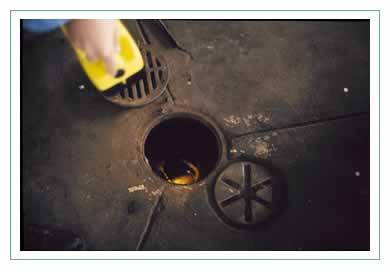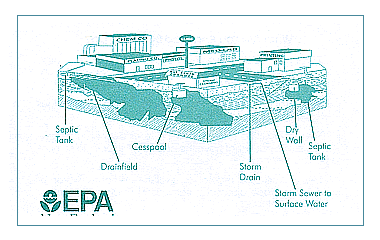Ground Water Discharges (EPA's Underground Injection Control Program)
Most ground water used for drinking occurs near the earth's surface and is easily contaminated. Of major concern is the potential contamination of underground sources of drinking water by any of the hundreds of thousands of subsurface wastewater disposal injection wells nationwide. Waste disposal wells dispose of approximately 11 percent of the nation's fluid waste. Injection wells can be either beneficial or a major problem. These wells are used in a broad variety of ways from beneficial uses such as aquifer recharge and the production of oil, gas and minerals, to the improper use for disposal of toxic and hazardous wastes.
The Safe Drinking Water Act of 1974 established the basic framework for protecting the drinking water of the United States. Congress recognized the potential threat of injection wells to ground water quality when they passed this Act instructing the U. S. Environmental Protection Agency (EPA) to establish a national program to prevent underground injection activities that endanger drinking water sources. The EPA is required to regulate underground injection of fluids and fluid wastes through wells that discharge or that may discharge into or above an underground source of drinking water. EPA has promulgated a series of Underground Injection Control (UIC) regulations to protect underground sources of drinking water. States may choose to have primary responsibility for carrying out these regulations. In New England, all six states are authorized to administer State Underground Injection Control Programs. The EPA New England Region works with state, tribal and local governments to support their management of injection wells in order to prevent contamination of drinking water resources by these wells. EPA provides states with technical support and program guidance.
EPA defines six classes of injection wells according to the type of waste they inject and where the waste is injected. New England State Underground Injection Control Programs focus primarily on regulation of shallow Class IV and Class V wells. There are no known Class I, II or III injection wells in New England. Non-hazardous fluids and wastewater are commonly discharged below ground through several Class V well types. There are many different types of Class V wells; however, they are all similar in their basic function--to dispose of waste fluids underground. EPA adopted a new rule for Class V wells which sets new requirements for large-capacity cesspools and motor vehicle waste disposal wells.

Class V subsurface wastewater disposal wells are common in New England. Often they are located in rural and/or unsewered areas where people depend on ground water for their drinking water. Some Class V wells are technologically advanced wastewater disposal systems used by industry; however, many injection wells are "low tech" man-made or improved "holes" in the ground that are deeper than their widest surface dimension. Generally, they are shallow and depend upon gravity to drain or "inject" fluid waste underground. New England Class V well injection systems commonly use septic system leach fields, leaching pits and trenches, dry wells, cesspools and wells to dispose of their wastes. When properly sited, constructed, and operated, these systems can be an effective and environmentally safe means of waste disposal. A Class V well's potential to endanger a nearby underground drinking water supply source depends largely on the type and/or quantity of fluid it injects. Their simple construction provides little or no protection against possible ground water contamination; so, it is important to control what goes into wastes discharged. See EPA's 1999 Class V Underground Injection Control Study for further information about the types of wells found nation-wide.
EPA requires all well owners and operators to submit inventory information about their wells; and, EPA and state regulations prohibit well operators from endangering underground drinking water sources. Owners of injection wells are not allowed to discharge fluids or waste fluids containing any contaminant that may cause a violation of any National Primary Drinking Water Quality Standard or that may otherwise adversely affect human health. Class V wells that inject Resource Conservation Recovery Act (RCRA) listed hazardous waste are Class IV wells and Class IV wells are prohibited by federal and state law.
If a facility generates waste fluids and is not connected to a municipal sewer, it is important to find out where sewage and non-sewage fluid wastes are discharged. If these wastes are discharged into a septic system, dry well, leach field, leaching pits and trenches, cesspool or well, the facility may have a Class V subsurface wastewater disposal well which may endanger a drinking water supply. If the facility has an injection well, the owner or operator should call their State Underground Injection Control Program for information concerning the best ways to manage their wastewater disposal.

